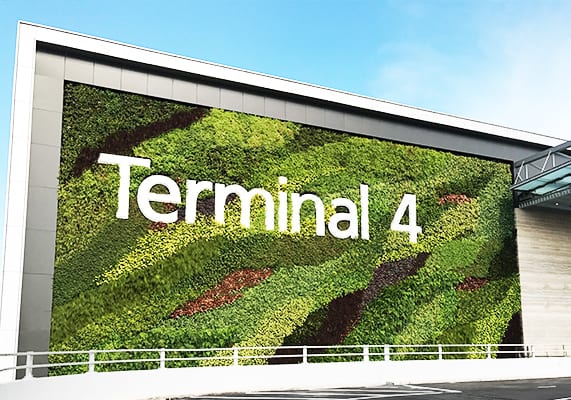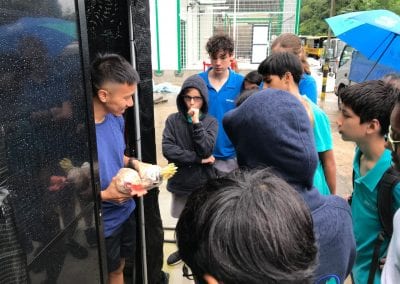
by eal | Dec 14, 2018 | Garden Updates, Uncategorized
On Wednesday we visited Citizen farm – an urban garden in the heart of Singapore. It was fantastic to see their Aquaponics, salad greens, botanics, insect and mushroom farm and all the innovative ways in which they are doing urban gardening. We had a guided tour with Darren which was really interesting.
Something I saw at the Citizen farm that I found interesting was…
“Tyre pot and mushroom house.”
“Marigolds!”
“All of the little chicks and the scent”
“The way that farmers could choose what type of lighting that they thought belonged in their farm. I also learnt that the lights can make the plants grow faster and that to make them grow at even rates.”
Something about the way that they do urban gardening at the Citizen farm that helps them to be successful is…
“They are always working at it”
“They are achieving a circular economy”
An idea from Citizen farm that we might want to use/adapt in our gardening could be…
“Tyre pots!”
“Edible flowers”
“the fish poop (for fertiliser)”
“indoor hydroponics / aquaponics”
What did we learn from our visit?
I thought their use of aquaponics (fish and hydroponics) was very innovative and efficient. For areas with limited space, this solution not benefits the aqua life, but also the plants.
An idea we could steal is the idea of indoor farms, we could create one in the big space between the bus bay and the high school building. We could also take the idea of making tires as the holders of the soil and the plants.
Its interesting how they have a circle of life: the bugs are food for the fish; the fish get poop making the compost for the soil; the plants are then used for food and it happens all over again.
Depending on our resources, we may want to invest in a small aquaponics tank (if it complies with the stagnant water rules) or make our gardens more efficient by introducing more insects to break down the compost in the soil.
I liked the way that farmers could choose what type of lighting that they thought belonged in their farm. I also learnt that the lights can make the plants grow faster and that to make them grow at even rates.
A secret to their success is their community outreach & great use of limited space.

by kawad50188 | Dec 5, 2018 | Learn something new!, Uncategorized
Singapore is widely recognized as the greenest city in Asia. From an unsanitary port city in the 1860s, it had become a green and livable first world city in just a few decades. The change started in 1970 when former Prime Minister Lee Kuan Yew directed a tree planting campaign be organized across Singapore. He personally chaired the Garden City Action Committee which was then set up within the Ministry of National Development.
Singapore aims to cut carbon emissions intensity by 36 per cent of 2005 levels, and one way of doing so is to add more greenery to the many high-rise building we have that are the biggest consumers of energy in the city.
Adding greenery to roofs and walls can reduce the amount the heat that penetrates the building by 60-70% according to Zac Toh, the founder, and director of greening firm GWS Living Art. GWS Living Art is a company which specializes in urban green technology that adds artistic green to roofs and walls. If the temperature inside the building is lowered, the need for air-conditioning in the buildings will be reduced. For example, Changi Airport Terminal 4’s wall is 550 meter square of greenery.
Today, over 13% of Singapore’s land area is dedicated to greening the urban landscape and maintaining a healthy ecosystem. This includes parks, park connectors, green spaces and nature reserves. Previously, priority was given to man-made greening of highways, streets and residential areas and not enough effort had been used to restore and preserve the natural areas left in Singapore. But in recent years, Singapore had retained several restricted nature reserve sites such as Sungei Buloh Wetland Reserve (131 hectares), Central Catchment (3043 hectares), Bukit Timah (163 hectares) and Labrador Nature Reserves (10 hectares). These places are where land development had been prohibited and ecosystems protected to preserve its heritage. The reserves are used for research in preserving and revitalizing biodiversity in Singapore and educating the public.
Sustainable Singapore Blueprint Video: What if?
https://www.youtube.com/watch?v=pzj7cqXkW5c
Bibliography:
https://www.eco-business.com/news/can-singapore-the-city-in-a-garden-grow-into-a-city-in-nature/
http://www.biodiversity.sg/biodiversity-information/view-slideshow/singapore-an-interesting-case-study/vision-of-a-green-city/
https://www.nparks.gov.sg/biodiversity
https://www.nparks.gov.sg/about-us/mission-and-history












